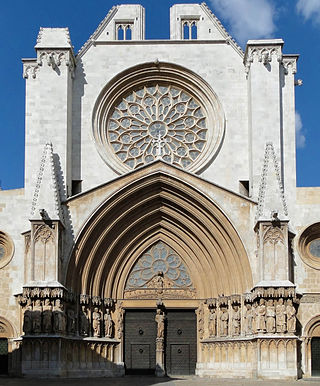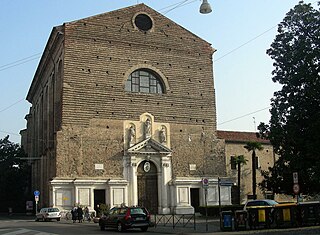
The Papal Basilica of Saint Peter in the Vatican, or simply Saint Peter's Basilica, is a church built in the Renaissance style located in Vatican City, the papal enclave that is within the city of Rome, Italy. It was initially planned by Pope Nicholas V and then Pope Julius II to replace the aging Old St. Peter's Basilica, which was built in the fourth century by Roman emperor Constantine the Great. Construction of the present basilica began on 18 April 1506 and was completed on 18 November 1626.

The Vall de Boí is a narrow, steep-sided valley and a small municipality in the province of Lleida, in the autonomous community of Catalonia, northern Spain. It lies in the northeastern corner of the comarca of Alta Ribagorça, on the edges of the Pyrenees. It is the largest municipality of the region, with its main town being Barruera.

The Candelária Church is an important historical Roman Catholic church in the city of Rio de Janeiro, in southeastern Brazil. It was built and decorated during a long period, from 1775 to the late 19th century. The church combines a Portuguese colonial Baroque façade with later Neoclassical and Neo-Renaissance interior elements.

Santa Maria presso San Satiro is a church in Milan. The Italian Renaissance structure (1476-1482) houses the early medieval shrine to Satyrus, brother of Saint Ambrose. The church is known for its false apse, an early example of trompe-l'œil, attributed to Donato Bramante.

Santa Maria del Carmine is a church of the Carmelite Order, in the Oltrarno district of Florence, in Tuscany, Italy. It is famous as the location of the Brancacci Chapel housing outstanding Renaissance frescoes by Masaccio and Masolino da Panicale, later finished by Filippino Lippi.

San Frediano in Cestello is a Baroque-style, Roman Catholic church in the Oltrarno section of Florence, region of Tuscany, Italy. The name cestello derives from the Cistercians who occupied the church in 1628. Previously the site had a 1450s church attached to the cloistered Carmelite convent of Santa Maria degli Angeli.

The Église Saint-Augustin de Paris is a Roman Catholic church located at 46 boulevard Malesherbes in the 8th arrondissement of Paris. The church was built between 1860 and 1871 by the Paris city chief architect Victor Baltard. It was the first church in Paris to combine a cast-iron frame, fully visible, with stone construction. It was designed to provide a prominent landmark at the junction of two new boulevards built during Haussmann's renovation of Paris under Napoleon III. The closest métro station is Saint-Augustin

Santa Maria del Carmine is a church in Pavia, Lombardy, northern Italy, considered amongst the best examples of Lombard Gothic architecture. It was begun in 1374 by Gian Galeazzo Visconti, Duke of Milan, on a project attributed to Bernardo da Venezia. The construction followed a slow pace, and was restarted in 1432, being finished in 1461.

Sant'Agrippina is a Roman Catholic church building in the town of Mineo, province of Catania, Sicily, that dedicated to the town's patron, Saint Agrippina of Mineo, sometimes known as Saint Agrippina.

The Basilica di San Pietro di Castello, commonly called San Pietro di Castello, is a Roman Catholic minor basilica of the Patriarch of Venice located in the Castello sestiere of the Italian city of Venice. The present building dates from the 16th century, but a church has stood on the site since at least the 7th century. From 1451 to 1807, it was the city's cathedral church, though hardly playing the usual dominant role of a cathedral, as it was overshadowed by the "state church" of San Marco and inconveniently located. During its history, the church has undergone a number of alterations and additions by some of Venice's most prominent architects. Andrea Palladio received his first commission in the city of Venice from the Patriarch Vincenzo Diedo to rebuild the facade and interior of St Pietro, but Diedo's death delayed the project.

The Cathedral of Tarragona is a Roman Catholic church in Tarragona, Catalonia, Spain. The edifice is located in a site previously occupied by a Roman temple dating to the time of Tiberius, a Visigothic cathedral, and a Moorish mosque. It was declared a national monument in 1905.

Notre-Dame-de-Lorette is a Roman Catholic Church located in the 9th arrondissement of Paris, It was built between 1823 and 1836 in the Neo-classical architectural style by architect Louis-Hippolyte Lebas, in a neighbourhood known as the New Athens, for its many artistic and scholarly residents in the 19th century, including George Sand, Pierre-Auguste Renoir, and Alexandre Dumas. While the exterior is classical and austere, the church interior is known for its rich collection of paintings, sculpture, and polychrome decoration.

Santa Maria del Carmine is a church in Milan, Italy. It was built in 1446.

San Martino church, also called San Martino Maggiore is a Gothic-style, Roman Catholic church located at the corner of Via Marsala and Via Guglielmo Oberdan in Bologna, region of Emilia Romagna, Italy. The church was founded by the adjacent Carmelite monastery. On 25 August 1941, Pope Pius XII elevated it to the status of basilica and imposed on the Archbishop of Bologna, Mario Corneliano to Pontifically crown the venerated Marian image of Our Lady of Carmel since 10 August 1704 via the authority of the Vatican Chapter under Pope Clement XI.

The "Sanctuary of Our Lady of Mount Carmel", better known as Carmine Church, is a Roman Catholic church in Via Porta Imperiale, Messina, Sicily. It replaces the former church, which was razed by the 1908 Messina earthquake. Located close to the Tribunal, the Carmine Church was rebuilt in 1930 in the eighteenth century Baroque or Rococo style. Designed by the architect Cesare Bazzani, the church was reconsecrated on 15 July 1931.

Santa Sofia is a Roman catholic church located in the Piazza of Anacapri, on the island of Capri, Italy. It dates to 1596 when it replaced Chiesa di Santa Maria di Costantinopoli as the parish church. Some of the building materials and fittings, such as the sacristy and oratorio, were originally in the Chiesa di San Carlo. The church chapels are dedicated to Sant'Antonio, Anacapri's patron saint, and the Madonna del Buon Consiglio. Architectural features include two bell towers and a baroque facade. The wedding of Guiliana DePandi and Bill Rancic occurred at the Chiesa di Santa Sofia.

Angelo Italia was an Italian Jesuit and Baroque architect, who was born in Licata and died in Palermo. He designed a number of churches in Sicily, and later worked to reconstruct three cities following the 1693 Sicily earthquake.

Santa Caterina d'Alessandria or Saint Catherine of Alexandria is a Roman Catholic church with a main facade on Piazza Bellini, and a lateral Western facade facing the elaborate Fontana Pretoria, in the historic quarter of Kalsa in the city of Palermo, region of Sicily, Italy. In front of the main facade, across the piazza Bellini, rise the older churches of San Cataldo and Santa Maria dell'Ammiraglio, while across Piazza Pretoria is the Theatine church of San Giuseppe and the entrance to the Quattro Canti. Refurbished over the centuries, the church retains elements and decorations from the Renaissance, Baroque, and late-Baroque (Rococo) eras. This church is distinct from the Oratorio di Santa Caterina found in the Olivella neighborhood.
The Mother Church of Sant'Ignazio is a Baroque-style, Roman Catholic church in the town of Scicli, province of Ragusa, Sicily, Italy.

The Basilica del Carmine is a 16th-century Roman Catholic church located on piazza Francesco Petrarca in Padua, region of Veneto, Italy. It was made a minor basilica in 1960 by pope John XXIII



















